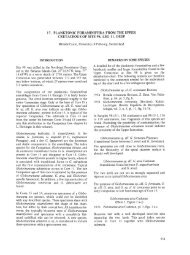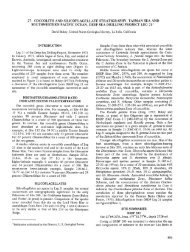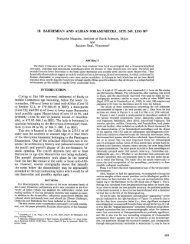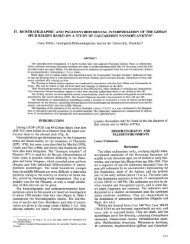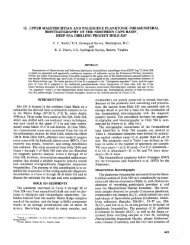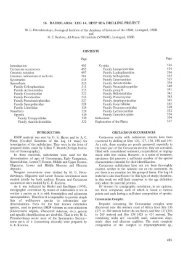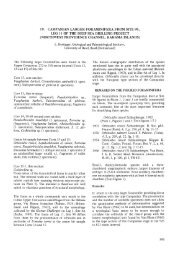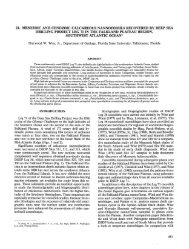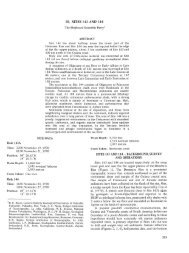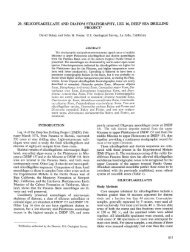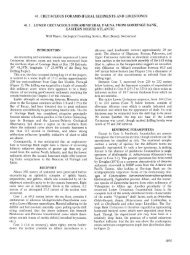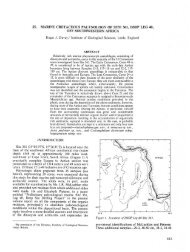Deep Sea Drilling Project Initial Reports Volume 42, Part 1
Deep Sea Drilling Project Initial Reports Volume 42, Part 1
Deep Sea Drilling Project Initial Reports Volume 42, Part 1
You also want an ePaper? Increase the reach of your titles
YUMPU automatically turns print PDFs into web optimized ePapers that Google loves.
DSDP 374<br />
LO , ==<br />
1<br />
2<br />
3<br />
/• >/<br />
— 65-66<br />
— 123-124<br />
— 136-138<br />
^144-146<br />
— 17-19<br />
— 145-147<br />
— cc<br />
TC CA<br />
(%)<br />
MC DO AR<br />
(Φ)<br />
Mz SA<br />
(%)<br />
SI CL<br />
49 10 18 9 12 6.2 - 89 11<br />
40 13 13 9<br />
29 23 2 4<br />
43 23 4 9<br />
46 6 14 19<br />
47<br />
45<br />
9<br />
11<br />
16<br />
17<br />
9<br />
2<br />
13<br />
15<br />
6.5<br />
9.0<br />
6.4<br />
5.1<br />
5. 3<br />
6. 2<br />
15 74 11<br />
3 38 59<br />
15 69 16<br />
32 63 5<br />
41<br />
29<br />
52<br />
43<br />
7<br />
28<br />
—cc 44 14 12 11 6.8 85 13<br />
Figure 1. Synopsis of carbonate mineralogy and grain size<br />
analyses. Core profile after visual core description (shipboard<br />
scientific party). TC = total carbonate, CA =<br />
calcite, MC=Mg-calcite, DO = dolomite, AR = aragonite,<br />
Mz = mean size (Folk), SA = sand, SI = silt, CL = clay,<br />
cc = core catcher.<br />
ably represent an eolian component within the originally<br />
shallow-water sediments.<br />
The Pleistocene sedimentation rate at Site 374 was<br />
about 15 cm/1000 years (Cita et al., this volume). On<br />
DSDP 374<br />
1<br />
2<br />
si<br />
4<br />
t<br />
1<br />
1<br />
-<br />
TC CA MC DO AR<br />
TURBIDITES AT SITE 374<br />
(Φ)<br />
Mz SA SI CL<br />
— — 2-4 22 18 - 8.3 1 56 43<br />
77-79<br />
79-81<br />
95-97<br />
115-116<br />
• 85-86<br />
— CC<br />
31<br />
29<br />
23<br />
21<br />
27 -<br />
27 -<br />
21 -<br />
19 -<br />
4<br />
2<br />
2 -<br />
2<br />
29 23 - 6<br />
32 21 3 4 4<br />
34 11 9 8 6<br />
— 96-97 53 7 1 0 2 24 6.2 19 66 15<br />
— 138-139 51 12 13 8 18 7.6 9 51 40<br />
Figure 1. (Continued).<br />
the Mediterranean Ridge, the sedimentation rate calculated<br />
for that part of the Pleistocene sequence which<br />
can be cored by piston cores (maximum length about<br />
16 m) is dependent on differing chronological interpretations<br />
of the climatic curves. They vary between 2.4<br />
cm/1000 years (Cita et al., in press) and about 6 cm/<br />
1000 years (e.g., Hieke, 1976). In either case, the<br />
sedimentation rate at Site 374 is much higher than in<br />
the adjacent ridge area. If one assumes that the cored<br />
sections of Site 374 are representative of the whole<br />
Quaternary sequence, the thickness and occurrence of<br />
the clearly recognizable turbidite layers within Cores 1<br />
to 5 are not sµfficient to explain the huge sedimenta-<br />
6.3<br />
9.1<br />
7.0<br />
8<br />
2<br />
1<br />
80<br />
34<br />
73<br />
12<br />
64<br />
26<br />
399



